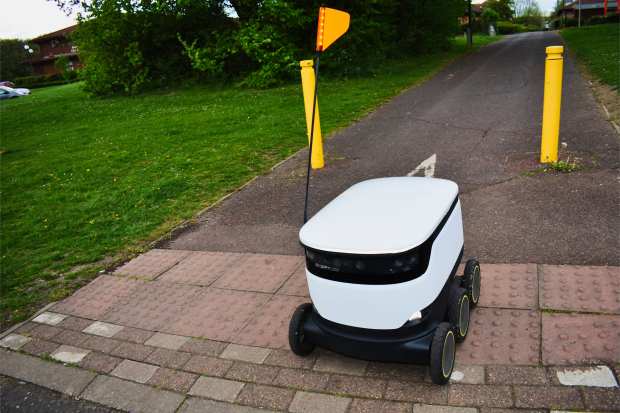What’s Driving The Future Of Autonomous Delivery?

Even boats are becoming autonomous these days — another sign of the autonomous revolution that is playing out on college campuses, city streets and in the air above our businesses and homes. That said, the disruption taking place these days — and the disruption that will come in the early part of the 2020s — is much more about getting products to consumers than enabling them to ride in comfort as a robot handles the driving (or sailing).
Indeed, while so many thoughts are targeted on the oncoming future of autonomous cars and vehicles, the real story happening right now is focused on food and other retail shipments, and on solving the always vexing problem of last-mile deliveries. Technology is progressing as consumer attitudes shift on what constitutes effective deliveries. While regulations have not yet caught up to some of the facts on the ground, the trend is clear — autonomous technology promises to play an increasingly important role in fulfillment in the decades to come.
Alphabet Effort
Signs of significant movement in the autonomous delivery space are easy to come by.
For instance, Alphabet, the owner of Google and the Waymo self-driving technology unit, recently announced that it wants to hire at least 24 people to expand its Wing drone company to better compete in an increasingly crowded field. Wing, which already works with Walgreens, wants to expand its delivery service in the United States and other countries as well. The company started as part of X (formerly called Google X), Alphabet’s moonshot factory — and it has fewer than 200 people working for it. Wing wants to deliver things like medicine, food and coffee in as little as minutes, and it’s also trying to create software that can handle multiple drone deliveries for other parties.
To do all that, however, Wing wants to expand its legal team by hiring a product counsel and a regulation lead to help foster company agendas with air regulators — a reflection of what other operators in this field also must deal with. There are specific issues with privacy and other regulations that drone companies have to deal with while they grow.
Other Deployments
The future of autonomous deliveries is not only playing out with jobs, but on college campuses.
Starship Technologies, a company that deploys self-driving robots, will expand and deliver everything from Starbucks to pizzas — but not booze — to college students all around the country, through partnerships with food companies Sodexo and Compass Group. The latest campuses that will get the delivery robots are Purdue University, University of Pittsburgh, George Mason University and Northern Arizona University. Indiana University will see them in September. Students can use the Starship app for 24/7 deliveries, and can also use a meal card if items they’re ordering are covered in the plan. Delivery fees typically run between $1 and $2, and the items generally arrive within 30 minutes.
Starship Technologies CEO Lex Bayer said the robots will be in about 100 campuses by 2021. Starship has raised about $40 million to aid in the expansion, and it’s raised a total of $85 million so far. Bayer said the delivery robots are ideally suited for college campuses, where there are often narrow passages and places where cars aren’t allowed to go, or cannot even fit. He also said the vehicles are good for the local economy, as they’ll help stores in the area.
That said, there are currently nine states that allow the robots, Bayer said, which will give the company a reach of around 100 million people. But he and other backers of the technology have good reason to be optimistic about the regulatory aspect of autonomous deliveries: regulation for the autonomous robots, unlike self-driving cars and drones, has come relatively easily. They’re not as heavy and they’re smaller and slower, which means they’re not as dangerous or likely to cause damage or death.
Delivery Trends
The Starship Technologies college campus effort takes in another big trend in commerce — one of the big trends helping to drive deployments of autonomous delivery vehicles, in fact. That’s the increasing important of online food delivery options, and the increasing impatience of consumers when waiting on those deliveries. As PYMNTS research has demonstrated, the projected value of restaurant deliveries will reach $62 billion by 2022 — that’s up from $25 billion in 2019.
And as more consumers order food online, they are getting less willing to tolerate tardiness. In fact, as PYMNTS found, 90 percent of consumers are unwilling to wait longer than 10 minutes for food ordered via mobile apps — a factor that, in general, is certain to increase the appeal of autonomous delivery vehicles, assuming they can move quickly. Indeed, by 2023, 23 percent of U.S. consumers will use food delivery apps. It’s not hard to imagine the ecosystem that will have developed by them in tandem with more autonomous food delivery devices and services.
Significant Challenges
Let’s not get ahead of ourselves, though.
As many analysts and reports note, these are the infant days for autonomous delivery vehicles, with many lessons remaining to be learned and absorbed. Among them? The use of such technology will require, according to a recent report from ConsumerGoods.com, “CPGs … to adjust packaging, pack sizes and assortment for different delivery vehicles.” Not only that, but “delivering in tough weather could be an issue, too,” according to that report. As well, the report notes that such technology could be used as an assistant to a human delivery driver. For example, while finding a place to park the delivery truck, a driver can put the bot on the sidewalk to begin deliveries. And possibly, while the driver delivers packages to one house, the bot can begin delivery to others.
Whatever happens, it seems all but certain that autonomous delivery technology will play in important role in commerce in the 2020s, even as they take varying forms for various tasks.
